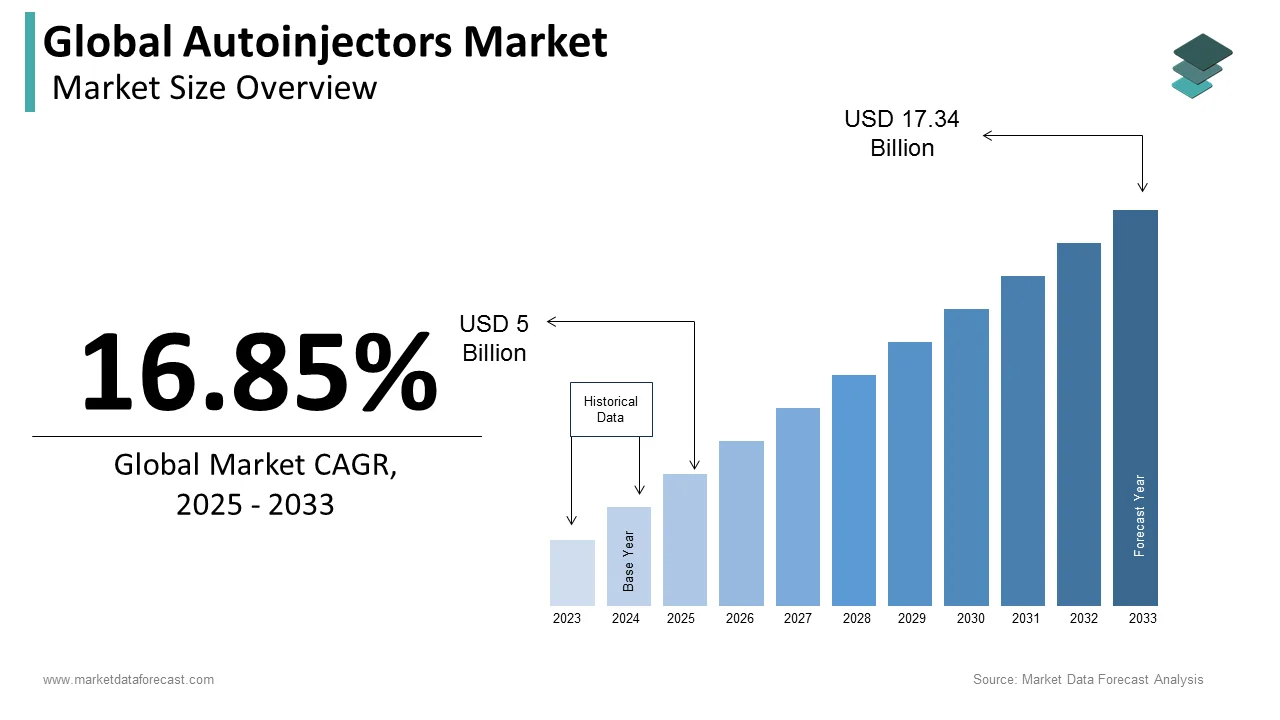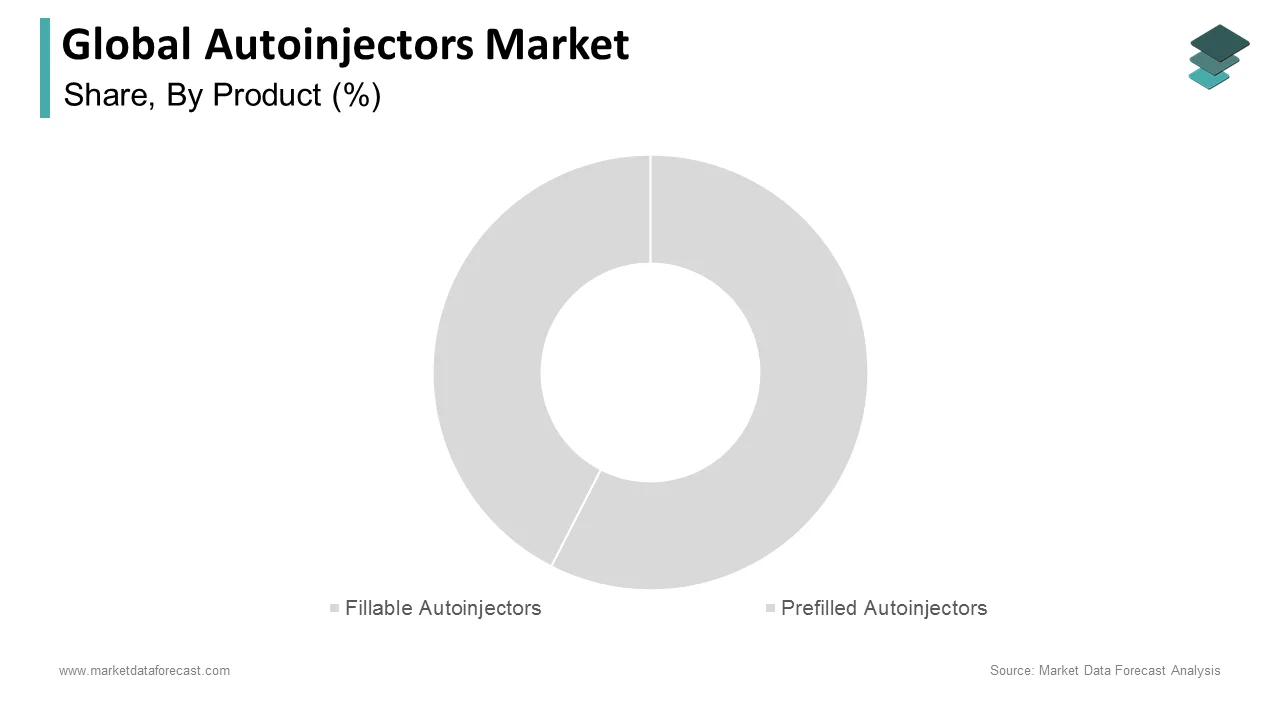Global Autoinjectors Market Size, Share, Trends & Growth Forecast Report By Product, Usability, Manufacturing Design, Technology, Application, Distribution Channels and Region (North America, Europe, Asia-Pacific, Latin America, Middle East and Africa), Industry Analysis From 2025 To 2033.
Global Autoinjectors Market Size
The global autoinjectors market was worth US$ 4.27 billion in 2024 and is anticipated to reach a valuation of US$ 17.34 billion by 2033 from US$ 5 billion in 2025, and it is predicted to register a CAGR of 16.85% during the forecast period 2025-2033.

Autoinjectors are used to deliver a single drug dose, mainly life-saving drugs. These autoinjectors are spring-loaded syringes primarily designed for drug-safe and secure application. The auto-injector delivery method has driven the market and made a paradigm shift. Self-injection devices are primarily used for delivering human growth hormones, and technologically advanced autoinjectors recently replaced insulin.
MARKET DRIVERS
Y-O-Y growth in the prevalence of anaphylaxis attacks is majorly driving the global autoinjectors market growth.
An anaphylaxis attack can be life-threatening. The growing incidence of these attacks is propelling the global autoinjectors market growth. The prevalence of these attacks is high in America compared to countries worldwide. The rising patient counts of diabetes, Rheumatoid arthritis patients, and cancer are some of the other vital factors responsible for fuelling the growth of the global autoinjectors market. Also, the approvals and funding given by the government are anticipating the growth of the global autoinjectors market.
In addition, factors such as technological advancements, innovation in drug delivery systems, and increased adoption of autoinjectors are expected to drive market growth. With the rising prevalence of diabetes and cancer, simplifying self-medication, and improving patient adherence, many advantages such as security, comfort, and precision favor market growth. Favorable government policies and high investments are further expected to push the global autoinjectors market growth.
MARKET RESTRAINTS
High prices, lack of awareness among patients towards self-medication, and injuries associated with autoinjectors are expected to hinder the growth rate of the global autoinjectors market. Moreover, stringent regulations, lack of awareness of self-injectors in the patients, and the infections caused by the needle- stick, and injuries are further anticipated to limit the global autoinjectors market growth.
REPORT COVERAGE
|
REPORT METRIC |
DETAILS |
|
Market Size Available |
2024 to 2033 |
|
Base Year |
2024 |
|
Forecast Period |
2025 to 2033 |
|
CAGR |
16.85% |
|
Segments Covered |
By Product, Manufacturing Design, Usability, Technology, Application, Distribution Channels, and Region. |
|
Various Analyses Covered |
Global, Regional, and country-level analysis; Segment-Level Analysis, DROC; PESTLE Analysis; Porter’s Five Forces Analysis, Competitive Landscape; Analyst Overview of Investment Opportunities |
|
Regions Covered |
North America, Europe, APAC, Latin America, Middle East & Africa |
|
Market Leaders Profiled |
Mylan N.V., Pfizer, Inc., Bayer AG, Becton, Dickinson and Company, Novartis AG, Biogen Idec, Inc., Janssen Global Services, LLC, Sanofi, Unilife Corporation and Eli Lilly and Company, and Others. |
SEGMENTAL ANALYSIS
By Product Insights

The prefilled autoinjectors segment had the major global market share in 2024 and is expected to remain dominant throughout the forecast period based on the product. Prefilled autoinjectors come with standard prefilled drug barrels and are simple to use. The most significant advantage provided by prefilled syringes is the elimination of dose errors.
By Usability Insights
Based on usability, owing to its ease of use, convenience, and patient preference, the disposable autoinjectors segment accounted for the largest share of the worldwide market in 2024. In addition, factors such as the growing awareness among patients, increasing preference of people towards self-administration, and rising demand for disposable autoinjectors due to increased incidence of anaphylaxis and other emergency conditions, combined with simple-to-use autoinjectors are primarily fuelling the segmental growth.
The segment of Reusable Autoinjectors is projected to be the fastest-growing segment during the forecast period. Reusable autoinjectors are provided in two types, like autoinjectors that are prefilled and empty.
By Manufacturing Design Insights
Based on the manufacturing design, the standardized autoinjectors segment is estimated to hold the largest share over the forecast period. Due to the factors such as the growing prevalence of cancer and diabetes, the presence of favorable reimbursement policies by governments, and increasing R&D activities around standardized autoinjectors.
On the other hand, the customized autoinjectors segment is estimated to showcase the highest growth rate during the forecast period.
By Technology Insights
Based on technology, the automated autoinjectors segment led the global market in 2024. Increasing preference for these automated autoinjectors among the patient population, particularly during emergencies, and raising awareness through campaigns are significantly pushing the growth of this segment. In addition, growing regulatory approvals and increasing usage of biologics for drug delivery are other factors propelling growth.
By Application Insights
Based on the application, the segment of anaphylaxis accounted for the highest share of the worldwide market in 2024, and the domination of the segment is anticipated to continue during the forecast period owing to the increasing incidence of anaphylactic due to stings of food, medicines, latex, and insects.
The segment of rheumatoid arthritis is anticipated to hold a substantial share of the global market throughout the forecast period. The growing usage of autoinjectors among the patient population suffering from rheumatoid arthritis is one of the major factors contributing to the segment's growth.
REGIONAL ANALYSIS

Regionally, North America had the largest share of the global market in 2024. The U.S. market accounted for a significant share of the North American region in 2024, and the domination of the U.S. in North America is expected to continue during the forecast period owing to the growing number of people suffering from anaphylaxis, rising disposable income, and growing pharmaceutical industry. In the United States, the rising prevalence of Anaphylaxis and Rheumatoid arthritis is favoring the market growth.
The Asia Pacific is anticipated to have a significant growth rate during the forecast period due to the growing presence of diabetic patient count and increasing population. In this region, countries accept and develop new products boosting the market growth. Similarly, India, China, and Japan are expected to contribute pointedly to the market growth.
Europe occupied the second-largest share in the global autoinjectors market in 2024. The European market is predicted to grow at a CAGR of 16.32% during the forecast period. The growing population suffering from chronic diseases and increasing funds and investments in research and development activities by the key players, particularly private organizations in this region, are fueling the market growth. In Europe, the German Autoinjectors market is predicted to lead the European autoinjectors market accounting for a substantial share during the forecast period.
The Latin American market is estimated to showcase a CAGR of 16% throughout the forecast period. Brazil is one of the leading nations, followed by Mexico, Argentina, and Columbia. The growth is allocated due to favorable government policies and funds from private organizations. In addition, the growth is attributed due to the growing investments contributed by the key players, increasing awareness associated with the utilization of auto-injectors, and also the support from the government.
The Middle East & Africa region is expected to have sluggish growth over the forecast period due to the deficient healthcare infrastructure, particularly in the African region.
KEY MARKET PARTICIPANTS
Some of the notable companies operating in the global autoinjectors market profiled in this report are Mylan N.V., Pfizer, Inc., Bayer AG, Becton, Dickinson and Company, Novartis AG, Biogen Idec, Inc., Janssen Global Services, LLC, Sanofi, Unilife Corporation and Eli Lilly and Company.
RECENT MARKET HAPPENINGS
- In November 2018, Teva’s Pharmaceuticals made a public statement in which they announced that they are releasing the generic version of EpiPen auto-injector 0.3mg in the U.S., which the U.S. FDA approved. It is used for patients who are suffering from the danger of allergic emergencies.
- In August 2018, Pfizer decided to contract with Antares set up to release an auto-injector for an unnamed drug.
- In May 2017, Bayer won FDA approval for the Beta Connect auto-injector. This Beta Connect auto-injector manages Betaseron for fragile patients. In addition, it allows the patient to connect with the new software, my beta app, to share their health data with the healthcare team.
MARKET SEGMENTATION
This market research report on the global autoinjectors market has been segmented and sub-segmented based on the product, manufacturing design, usability, technology, application, distribution channels, and region.
By Product
- Fillable Autoinjectors
- Prefilled Autoinjectors
By Usability
- Disposable Autoinjectors
- Reusable Autoinjectors
By Manufacturing Design
- Standardized Autoinjectors
- Customized Autoinjectors
By Technology
- Automated Autoinjectors
- Manual Autoinjectors
By Application
- Anaphylaxis
- Multiple Sclerosis
- Rheumatoid Arthritis
By Distribution Channels
- Hospitals
- Retail
- Online Pharmacies
- Others
By Region
- North America
- Europe
- Asia Pacific
- Latin America
- Middle East and Africa
Related Reports
Access the study in MULTIPLE FORMATS
Purchase options starting from $ 2500
Didn’t find what you’re looking for?
TALK TO OUR ANALYST TEAM
Need something within your budget?
NO WORRIES! WE GOT YOU COVERED!
Call us on: +1 888 702 9696 (U.S Toll Free)
Write to us: [email protected]
